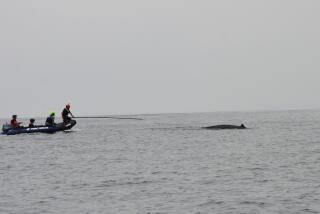Treading new waters with a dolphin’s tail
- Share via
CLEARWATER, FLA. — Prosthetic specialist Kevin Carroll travels the country tackling the toughest human amputation cases, so it was only natural that he also was drawn to Winter -- the only known dolphin to survive the loss of her powerful tail flukes.
“My heart went out to her, and I was thinking I could probably put a tail on her,” said Carroll, vice president of prosthetics at Hanger Orthopedic Group Inc.
Re-creating one of the most powerful swimming mechanisms in nature turned out to be a lot tougher than expected. But after months of experimenting, Carroll and a team of experts are well on their way to, as one of them puts it, “MacGyvering” a tail for 18-month-old Winter.
Unlike the 1980s cult TV hero “MacGyver,” who worked his way out of tight spots with everyday items, much of what Winter’s team is creating is first-of-its-kind stuff.
“We put together a team who doesn’t know what ‘no’ means,” said Mike Walsh, Winter’s lead veterinarian and a program manager at the University of Florida’s aquatic animal health program. “As long as you’re willing to try, you can make a big difference.”
Some lessons could help human amputees. Carroll, for example, found that the gel sleeve he developed to cling to Winter’s tail without irritating her sensitive skin also soothed a painful prothesis for Air Force Senior Airman Brian Kolfage, who lost both legs and his right hand in a 2004 mortar attack in Iraq. The sleeve sticks to Winter’s tail with suction the same way a rubber surgical glove grips a human hand.
“When he tried to walk with prosthetics, you had these dagger-like boney growths sticking into the socket. It was very painful,” Carroll said. “Brian’s situation was similar to Winter’s. Winter helped him and hopefully she’ll help a lot of others as well.”
Carroll, an Orlando, Fla., resident whose company is based in Bethesda, Md., said he was already thinking of new materials to make human prosthetics tougher in salt water. And Walsh said the research on Winter was invaluable for understanding dolphin physiology and the treatment of back injuries, which could occur when dolphins were beached.
Winter lives at the Clearwater Marine Aquarium, a nonprofit marine animal rescue center and local attraction in the Gulf Coast city’s former water treatment plant.
She was a frail, dehydrated 3-month-old when she came to the hospital in December 2005. A fisherman found her tangled in the buoy line of a crab trap in Indian River Lagoon near Cape Canaveral, Fla. The line had cut off the blood supply to her tail and it slowly fell off like shreds of paper as the aquarium team worked to save her life.
Winter learned how to swim without her tail, which is used for propulsion. She amazed her handlers with a unique combination of moves that resemble an alligator’s undulating swimming style and a shark’s side-to-side tail swipes.
Winter uses her flippers, normally employed for steering and braking, to get moving.
But her unique swimming style is sure to lead to spinal problems. Already, she sometimes bends her spine in an unnatural curve.
Trainers work with Winter on an extensive physical therapy regimen, bending the prosthetic tail up and down to keep the correct muscles strong.
Walsh said allowing Winter to work out daily with a prosthetic tail might keep her from deteriorating. It is unlikely she will wear the tail full-time.
She is now 6 feet long and a healthy 180 pounds.
But she’s in uncharted territory. Fuji, an elderly dolphin that lives at an aquarium in Japan, has a prosthesis, but it is attached to the remaining part of his tail. Both of Winter’s tail flukes and peduncle, a wrist-like joint that enables the tail to move up and down, were lost.
Winter’s team also has to figure out how to keep the prosthesis from sliding off, because the tail must create enough force to propel a dolphin out of the water and 10 feet into the air.
“Every step we take is unknown,” Clearwater Marine Aquarium Chief Executive David Yates said. “Another group came to us, analyzed her and said . . . they didn’t know how to make the tail stay on. But Kevin came to us and said, ‘We’ve got the technology. We can do this.’ ”
Carroll, who volunteers his time and resources like others on Winter’s team, began by brainstorming elaborate vacuum attachments, but he eventually settled on the simple silicone gel sleeve.
Dolphin handlers slide the sleeve over Winter’s stump and move her tail in up and down motions, teaching her how to swim normally when the prosthesis is attached.
It is a slow process. They don’t want Winter to balk at the strange new attachment.
“I thought I could go down, cast her [tail stump] and put the tail on her,” Carroll said. “I didn’t understand the training that had to go with each fitting of the tail. Working with Winter, we’re on her time, not my time. If she’s ready to do something, we move forward. It’s the same way working with a child. It takes a lot of time.”
The team plans to keep socializing Winter with new pieces until, at a point yet to be determined, they will attach the first artificial tail flukes. They plan to start out with small flukes that create a little resistance.
“She is the perfect dolphin for what she has to do,” Yates said, watching Winter toy with a herring in her tank. “A lot of dolphins might reject this up front. But every step of the way she has excelled in everything we have asked her to do.”






